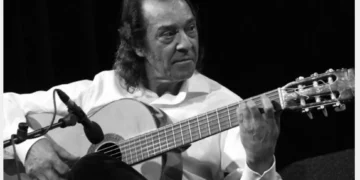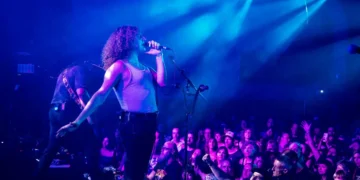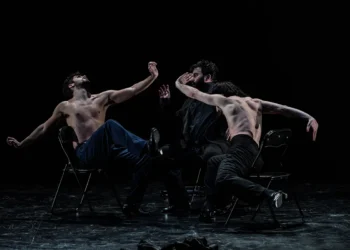|
Jesús Aguilera “Momentos flamencos” |
||||||
|
Special XIII Festival de Jerez 2009. All the information Photos: Ana Palma Photo gallery Jesús Aguilera “Momentos flamencos” Text: Estela Zatania Dance: Jesús Aguilera. Cante. Juan José Amador, father and son. Guitar: Pedro Sierra. Percussion: Antonio Montiel. The recorded sound of a Holy Week procession, and from under a table covered in velvet, which represented one of the religious floats, out popped Jesús Aguilera, who quickly tipped the table over and did footwork on the underside. The dancer had said he wanted to present flamenco dance in a straightforward bare-bones fashion, but in the end, couldn’t resist the urge to add theatrical flourishes, and had he continued in that vein, the outcome might have been better. But throughout the rest of the show, he maintained a monotonously even tone with taranto and tangos, soleá, alegrías, martinete and siguiriyas: much darkness, lots of Farruquito moves and lots of footwork. Towards the end, a woman came out dressed like a flamenco dancer, or perhaps she actually was a dancer, no way to tell. She appeared briefly in a splendid gold lamé costume with old lace. Not only was this an impressive sight, but it seemed to promise a change of pace, but after a minute or two of subtle armwork, she exited the stage leaving no clue as to the reason for her presence. Jesús Aguilera, dressed in suit and tie – a whole new look for a flamenco dancer, and not bad at all – has much to offer, no question about it, but on his own he wasn’t able to mount a coherent show, although we do understand the expense involved in hiring a director, choreographer, lighting designer, etc… But precisely for this reason, he should have kept to a less ambitious format, which would have been a sure bet thanks to the fine singing of Juan José Amador, father and son, and the brilliant guitar of maestro Pedro Sierra. Subtracting even more coherence, but adding truckloads of life and interest, at the end a small army of interprovincial flamenco faces (from Cádiz and Sevilla that is), appeared as if by magic. Even with the poor lighting, you could distinguish Lorenzo Gálvez “Ripol”, Javier Heredia, Bo and Luis Peña among the crowd. The fiesta had arrived and rescued us all from the tedium of this promising young dancer’s show. Antonio Márquez “Antonio” Dance: Antonio Márquez, Paco Romero (special guest artist). Corps de ballet: Trinidad Artiguez, David Sanchez, Daniel Fernández, Javier Sánchez, Joana Flores, Rocío Chacón, Carmen Alférez, Merche Recio, Verónica Soriano, Francesco Bucchi, Juan F. González, Víctor Rodríguez. Cante: Daniel Fernández. Guitar: David Durán. Percussion: Rafael Hermoso «Poti». Voice: Francisco Valladares. Script: Eva Leiva. Music: Salvador Barcarisse, Isaac Albéniz, Padre Soler, Juan Vert, Eduardo Lalo, Reveriano Soutullo. Text: Estela Zatania Pure nostalgia at the Villamarta on Friday night. The level of the presentation itself, wasn’t up to that of Antonio Márquez’ last appearance at this theater in 2005 when his show won the prize of the Cátedra de Flamencología for best show of the Festival de Jerez. Nevertheless, the magnitude of the intent was enough to stand on its own. Antonio Ruiz Soler, the Great Antonio, Antonio el Bailarín, El Chavalillo – the dimension of his personality required more than the usual number of nicknames – has made such an impact on flamenco and Spanish dance, that at this point, a young dancer sees the choreographies and remarks “but it’s the same old stuff everyone does”. Of course. In 2009, no flamenco or classic Spanish dancer can escape Antonio’s influence, because he created an aesthetic that has become part of the DNA of Spanish culture. Throughout the lengthy program, Antonio’s choreographic masterpieces are recreated with greater or lesser success, but it’s veteran maestro Paco Romero, who belonged to the company of the legendary dancer and has always followed that line, who gives coherence and adds the most moving touch, directing a rehearsal, remembering choreographies, dancing…. There is an informal biographic thread. Although you aren’t shown the importance of Rosario (Florencia Pérez), the other half of the Chavalillos, an artistic collaboration that lasted 22 years, other scenes, such as the early years in Seville, the years in New York, rehearsals, classes, etc, are graphically represented. Antonio’s flamenco facet is little developed, the most effective reference being the tanguillo with the recorded cante of Chano Lobato who toured the world with Antonio, but more attention is given to pieces like “Triana”, “Antonio el Camborio”, “Asturias” or Sarasate’s “Zapateado”. You miss the “Farruca del Molinero”, and “Amor Brujo” in general, and the martinete, danced for the first time by Antonio and included in the 1952 film “Duende y Misterio del Flamenco”, is not played up, but seems to come and go with little fanfare. For some spectators, this was an excessively cloying production, but for those of us of a certain age, it was a well-deserved tribute to one of the greatest stars in the history of Spanish dance. PEPE HABICHUELA Y DAVE HOLLAND Guitar: Pepe Habichuela; Double bass: Dave Holland, Second guitar: José Miguel Carmona; Third guitar: Carlos Carmona; Percussion: Piraña and Juan Carmona. Text: Manuel Moraga Music-lovers really enjoyed this group led by two veteran maestros, Dave Holland and Pepe Habichuela. It’s interesting to see how different shows attract different audiences: last night you could close your eyes during the show, and English and German were the languages most heard from the tables. Far more than Spanish or Japanese. And the average age was fairly high. The musicians took a while getting in the groove, while the sound of the monitors was fiddled with. It can’t be easy to get so many instruments correctly balanced on a small stage. Pepe Habichuela opened with a moving taranto: the bass supplied the “cante”, and Habichuela the accompaniment. The British musician followed with a solo, leaving no question as to his talent as a jazz-man. Holland has worked with people like Pat Methany, Herbie Hancock, Anthon Braxton, John Scofield and Jack DeJohnette. Siguiriyas full of ideas, and with implacable, rich rhythm, moving fandangos de Huelva, tangos, bulerías, rumba…pieces from Habichuela’s repertoire, one after another, and the rapport within the band just got better and better. They enjoyed playing together, and the audience enjoyed right along with them. Bravo! |



 XIII FESTIVAL DE JEREZ 2009
XIII FESTIVAL DE JEREZ 2009 























